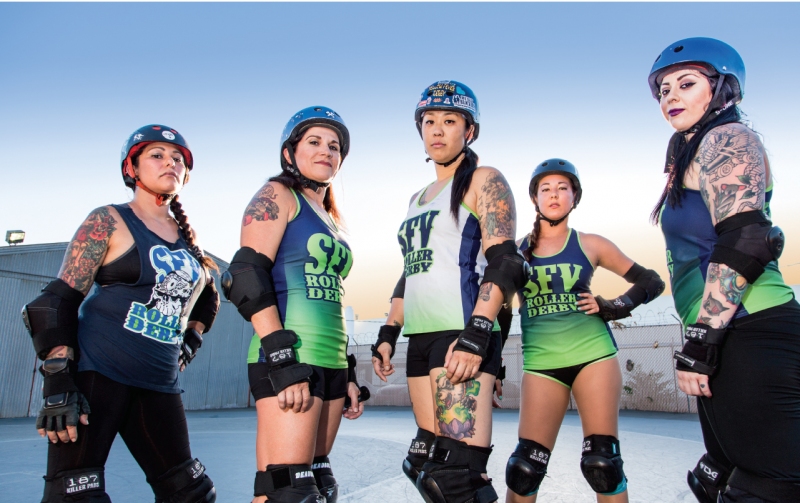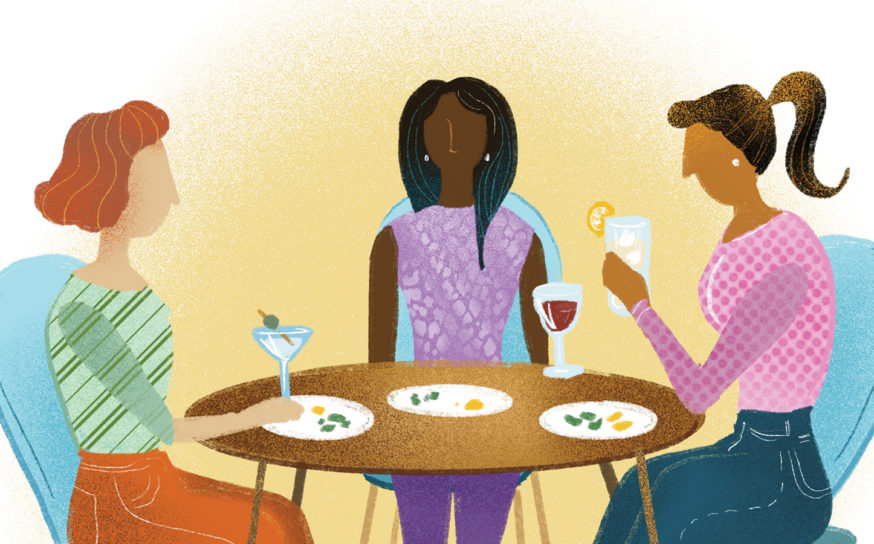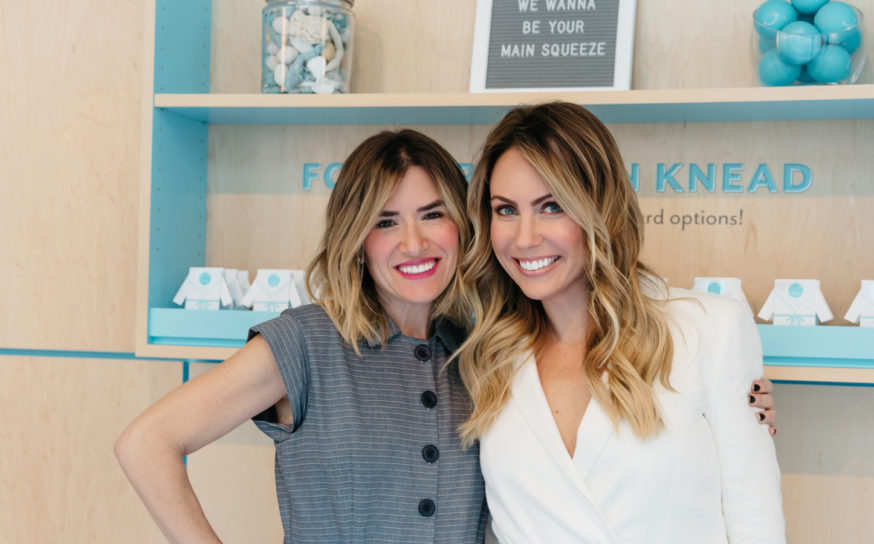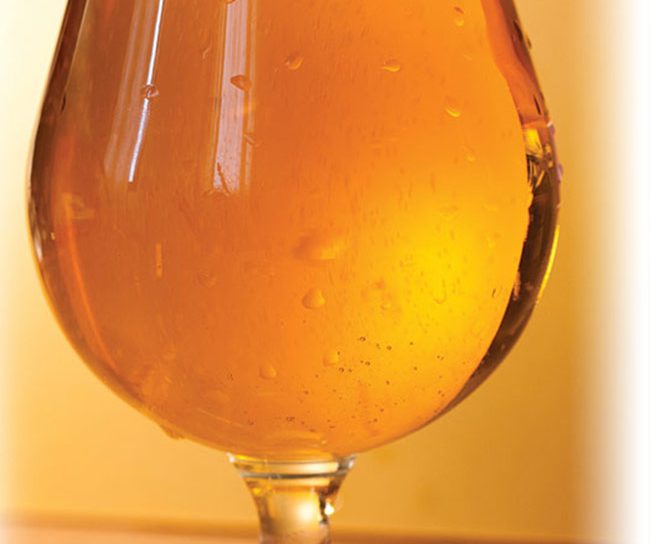
A Sisterhood on Skates
Old-time roller derby may have been campy and fake. But nowadays, as evidenced by one scrappy Valley team, it’s as real as it gets.
-
CategoryPeople
A doctor, a lawyer and a history professor walk into an outdoor roller rink. What happens next is a bit unexpected. The women hit each other. Repeatedly. And hard. But there’s no ill will involved, just the kind of pure, unadulterated physical fun that grown-up ladies seldom experience.
This is the San Fernando Valley Roller Derby league where about 100 women—ages 18 to 48—regularly step outside their everyday professional and familial personas and claim noms de guerre like Killo Kitty, Stockholm Syndi, Fearless Bueller and American Hurl Doll. They duke it out on a flat-track oval, with two five-women teams wrestling through each other’s lines to score points in two 30-minute bouts, by skating laps around the track.
“It’s definitely a sisterhood,” says Staci Park, a.k.a. Killo Kitty, the league’s founder and president. The 38-year-old is an office manager when not skating, training or running the all-volunteer league. “It helps girls feel stronger.” Killo used to skate with the L.A. Derby Dolls, who compete on a banked track, old-time derby style. But with three young daughters, commuting into downtown LA for practices and bouts was too time-consuming. So in 2011, she inaugurated the Valley’s first flat-track league. “I started this league so more women could skate and play and still have a life,” Killo states.
 The Valley league roller derby action takes place 50 weeks a year at a former auto impound lot in Sylmar, now owned by SFVRD, that’s been resurfaced with an acrylic coating to make it smooth enough for the old-fashioned quad skates the women wear. At 48, Gail Gomez, or “American Hurl Doll,” who is a film production accountant, is the league’s oldest member. “We get all walks of life here,” she says. “We have a Ph.D., authors, nurses, lawyers, a civil engineer.”
The Valley league roller derby action takes place 50 weeks a year at a former auto impound lot in Sylmar, now owned by SFVRD, that’s been resurfaced with an acrylic coating to make it smooth enough for the old-fashioned quad skates the women wear. At 48, Gail Gomez, or “American Hurl Doll,” who is a film production accountant, is the league’s oldest member. “We get all walks of life here,” she says. “We have a Ph.D., authors, nurses, lawyers, a civil engineer.”
Gomez’s teammate Shannon Ashworth or “Fearless Bueller,” a professional photographer who shoots all the SFVRD team portraits, has been playing for six years. The 35-year-old previously studied martial arts but started at zero with roller derby, learning to skate with the West Coast Derby Knockouts in Ventura. “When I first got started, I just thought it was fun. But later it was the community that kept me coming back,” she says. “It’s really inspiring. It’s very much a sisterhood. There are teams everywhere—all over the world.”
Although women’s flat-track derby may fly under many people’s radar, it is a fast-growing international sport. Regulated by the 11-year-old nonprofit Women’s Flat Track Derby Association (WFTDA, pronounced “Woofdah”), member leagues now number 378, growing from just 50 in 2005. The newest inductees hail from Paris, Tampere , and Dresden and Hamburg, Germany. As WFTDA’s site says, “Skaters are ‘normal’ during the day. Roller derby is our escape from day-to-day life and our opportunity to embrace a tougher, edgier side of ourselves. When you step into the rink, your derby alter ego takes over.”
WFTDA’s motto is “Real. Strong. Athletic. Revolutionary”—which is a pretty fair description of the sport. One thing that makes it unique is that, unlike any other current women’s competitive sport, contemporary flat-track derby began as exclusively female and not as an offshoot of a men’s sport. This time, it’s the men’s leagues that are the afterthought.
Today’s roller derby got its start in 2001 in Austin, with the Texas Rollergirls. The sport’s breakout year was 2006, when A&E aired a reality show about the Austin league called Rollergirls. The following year, Maggie Mayhem (IRL Shauna Cross) published her memoir Derby Girl, which was the basis for Drew Barrymore’s 2009 film Whip It. Killo worked on the movie and says that it portrays the culture of derby sisterhood with authenticity. “On a scale of 1 to 10, it’s probably a 7.5,” she says.
 The bar to entry is fairly low in roller derby, which helps explain its growing popularity. Bouts can be held anywhere there are patches of asphalt. And unlike ice hockey or triathlon that require hundreds or thousands of dollars of investment in equipment, roller-derby gear can cost as little as $150: skates; knee, elbow and wrist guards, a helmet, and a mouth guard. Monthly SFVRD dues are $65 and include the opportunity to practice at the Lot at least three days a week. But new recruits, dubbed “Fresh Meat,” don’t owe monthly dues until they’re sure they want to join; they pay $10 per training session and can borrow the needed equipment.
The bar to entry is fairly low in roller derby, which helps explain its growing popularity. Bouts can be held anywhere there are patches of asphalt. And unlike ice hockey or triathlon that require hundreds or thousands of dollars of investment in equipment, roller-derby gear can cost as little as $150: skates; knee, elbow and wrist guards, a helmet, and a mouth guard. Monthly SFVRD dues are $65 and include the opportunity to practice at the Lot at least three days a week. But new recruits, dubbed “Fresh Meat,” don’t owe monthly dues until they’re sure they want to join; they pay $10 per training session and can borrow the needed equipment.
How dangerous is it? Probably not as risky as you think. “It’s like any sport that you play,” says Killo. “People get hurt. But we train to do it safely and we have rules.” There are regulations against throwing elbows, hitting low, pushing, tripping and fighting. Old-time derby “clotheslining,” where teammates hold hands to upend an opponent, is off limits. In fact, the penalty box is one of the busiest zones during bouts, since there are seven referees watching players at all times and they are generous in handing out sanctions.
 Paramedics stand by at all bouts. Do women get injured? Yes. Broken wrists and ankles are the most common mishaps, especially among the “Freshies,” the nickname for the Fresh Meat girls. Even though she’s a top-level, A-Team player, Gomez recently needed stitches to close a sliced eye socket after another skater fell and kicked her in the face. Still, she has no plans to quit. “It’s addicting,” she says. “Roller derby fits me. I’m not afraid of physical contact.”
Paramedics stand by at all bouts. Do women get injured? Yes. Broken wrists and ankles are the most common mishaps, especially among the “Freshies,” the nickname for the Fresh Meat girls. Even though she’s a top-level, A-Team player, Gomez recently needed stitches to close a sliced eye socket after another skater fell and kicked her in the face. Still, she has no plans to quit. “It’s addicting,” she says. “Roller derby fits me. I’m not afraid of physical contact.”
SFVRD is currently ranked 90th out of the 378 leagues, right behind the Undead Bettys of Antioch, California and the Roc City Roller Derby crew of Rochester, New York. The #1 spot is held by the 13-year-old Gotham Girls Roller Derby of New York City, who are five-time WFTDA world champions. (LA’s 10-year-old Angel City Derby Girls is ranked #5.) The 2016 championship bouts are set for November 4-6 in Portland, Oregon, with the Rose City Rollers as the host team. The last day’s bouts are scheduled to stream live on ESPN3, which is a measure of just how powerful the derby sisterhood really is.











